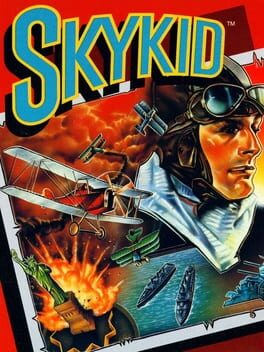Namcom is one of the oldest publishers and is no stranger to shoot'em ups, but Sky Kid appears as their first shoot'em up with horizontal scrolling. This precursory aspect surely explains the right-to-left scrolling – which coincides with the Japanese reading direction – but deviates from the standards of the genre. This is not the only peculiarity that makes Sky Kid a special title: it has a rather good-natured aesthetic, which strongly evokes the style of the anime Meitantei Hōmuzu (1984) by Hayao Miyazaki and Kyosuke Mikuriya, especially with the anthropomorphic animals. For the American version, all traces of this aestheticism have disappeared, as the cover insists on the World War I setting. This leads to an inconsistency that the localisation does not attempt to resolve. The protagonist's name, Baron, is clearly a reference to the Red Baron, yet it is German units that the player needs to destroy, as the Parteiadler is visible on the buildings – let's get past the confusion between WWI and WWII. Moreover, there is a noticeable tone discrepancy between the American boxart and the general style of the game: the American desire to make every title very serious and mature is quite funny.
The title places the player in a biplane, whose mission is to bomb strategic enemy buildings by retrieving a bomb in the level, before dropping it. The plane is also capable of firing projectiles at a very reasonable rate, as well as doing high yo-yos, which give i-frames and allow our biplane to be positioned behind the opposing forces. The particularity of the title is that the projectiles are influenced by the angle of the aircraft, which requires more or less subtle manoeuvres to get out of the way of an enemy squadron or to dodge a salvo of projectiles. The idea is quite good and correctly implemented, but the title suffers from an acute repetition of its content, insofar as the same screens are repeated from one level to another. While the different enemy projectiles create novelty during the first three stages, they fail to create the necessary diversity over the twenty levels that Sky Kid offers. On the other hand, it doesn't even seem necessary to bomb the strategic targets, except for bonus points, which pushes the player to avoid it, since carrying the bomb prevents from doing any yo-yo.
Finally, the sexualisation present in Sky Kid is somewhat surprising. It is not new, since it is directly inherited from Japanese manga and anime, but being able to lift the dress of the Statue of Liberty seems quite exaggerated and superfluous. If this trope is not unique to Japanese media, the way in which it is implemented is old and relies on a particular connivance with the spectator: Miss Machiko (1980-1982) is surely the most important expression of it at that time, with the famous 'Maicchingu!' This, as well as the cheerleaders – or girlfriends? – of Baron and Max point to the normalisation of a heterosexual sexualisation of women in Japanese games, which the American localisations are happy to retain: the fact that the protagonists are birds in the Japanese version reinforces this observation. Beyond these remarks, Sky Kid remains an acceptable title, relatively original for its time, which nonetheless suffers from repetition, as much in its gameplay as in its artistic realisation. Fatally, the title never had a sequel and its director, Hiromu Nagashima, later moved on to baseball games – is that why the main theme of Sky Kid was used by the Osaka Kintetsu Buffaloes?
The title places the player in a biplane, whose mission is to bomb strategic enemy buildings by retrieving a bomb in the level, before dropping it. The plane is also capable of firing projectiles at a very reasonable rate, as well as doing high yo-yos, which give i-frames and allow our biplane to be positioned behind the opposing forces. The particularity of the title is that the projectiles are influenced by the angle of the aircraft, which requires more or less subtle manoeuvres to get out of the way of an enemy squadron or to dodge a salvo of projectiles. The idea is quite good and correctly implemented, but the title suffers from an acute repetition of its content, insofar as the same screens are repeated from one level to another. While the different enemy projectiles create novelty during the first three stages, they fail to create the necessary diversity over the twenty levels that Sky Kid offers. On the other hand, it doesn't even seem necessary to bomb the strategic targets, except for bonus points, which pushes the player to avoid it, since carrying the bomb prevents from doing any yo-yo.
Finally, the sexualisation present in Sky Kid is somewhat surprising. It is not new, since it is directly inherited from Japanese manga and anime, but being able to lift the dress of the Statue of Liberty seems quite exaggerated and superfluous. If this trope is not unique to Japanese media, the way in which it is implemented is old and relies on a particular connivance with the spectator: Miss Machiko (1980-1982) is surely the most important expression of it at that time, with the famous 'Maicchingu!' This, as well as the cheerleaders – or girlfriends? – of Baron and Max point to the normalisation of a heterosexual sexualisation of women in Japanese games, which the American localisations are happy to retain: the fact that the protagonists are birds in the Japanese version reinforces this observation. Beyond these remarks, Sky Kid remains an acceptable title, relatively original for its time, which nonetheless suffers from repetition, as much in its gameplay as in its artistic realisation. Fatally, the title never had a sequel and its director, Hiromu Nagashima, later moved on to baseball games – is that why the main theme of Sky Kid was used by the Osaka Kintetsu Buffaloes?
